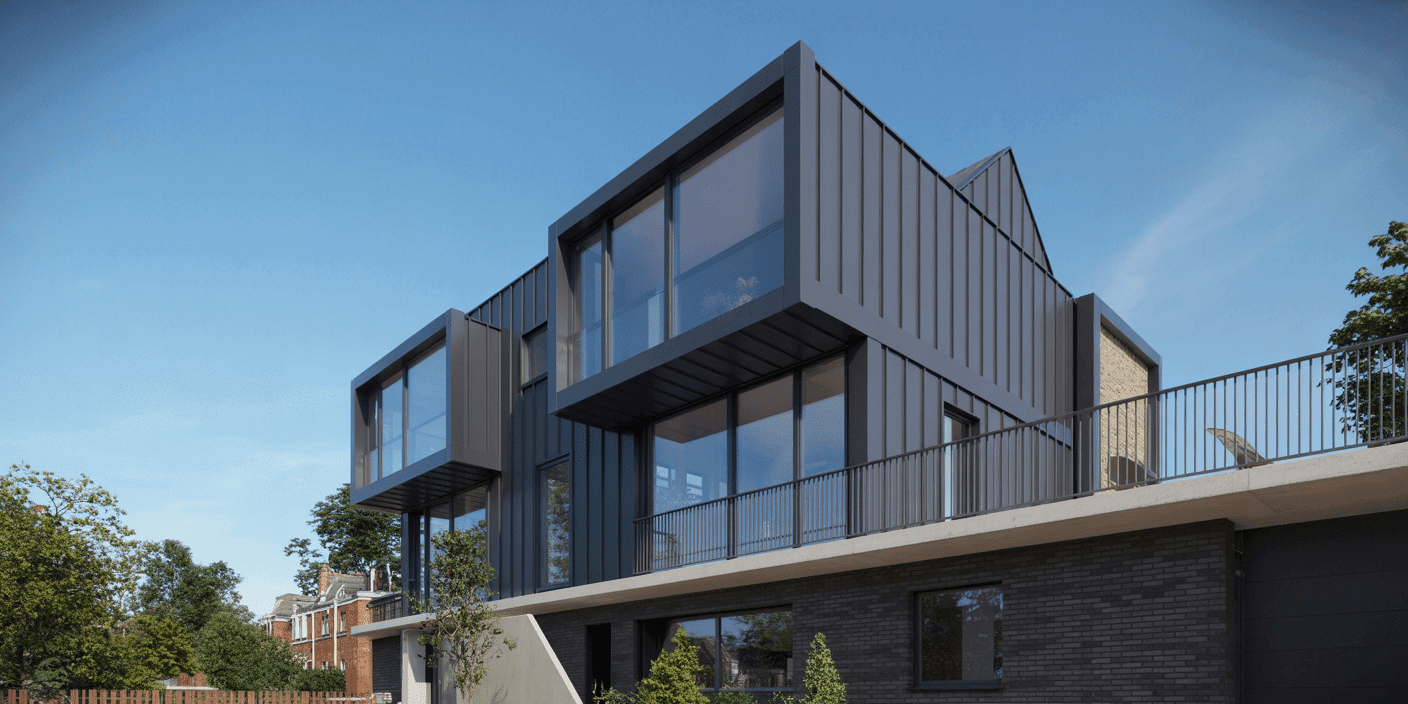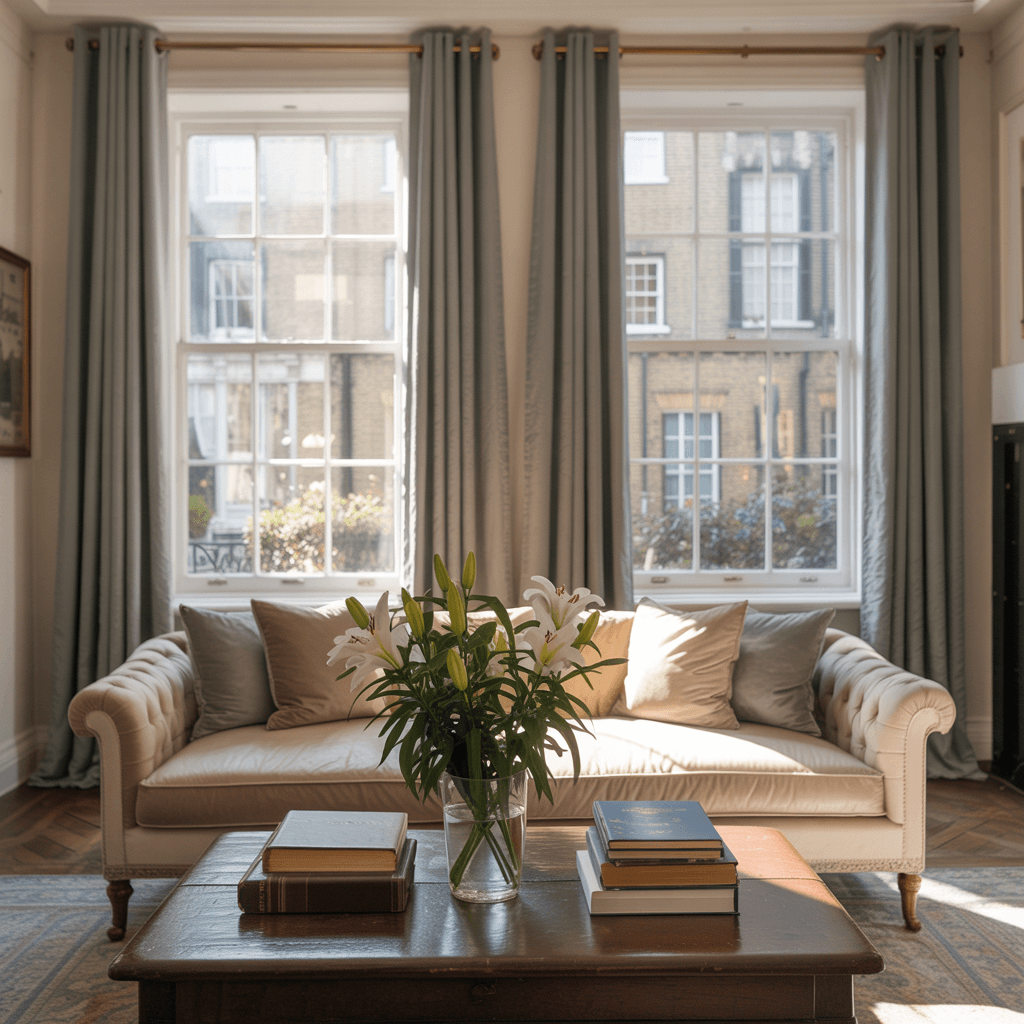The Hidden Cost of a Cold Room
You replaced your windows. The comfort never arrived. The bills never dropped. And the silence never came.
Like many homeowners, you followed the conventional path. The original timber frames were tired, rattling with the wind. So you opted for double glazing. You trusted the specification. You expected a measurable improvement.
But months later—perhaps on a still November morning—you feel it again: a faint chill around the frame. The thermostat climbs. So does your heating bill. And the room never quite feels as it should.
The reality is simple: most modern windows underperform.
Standard double glazing, while a step above single-pane, is no longer sufficient. It fails to meet the rising expectations of homeowners and regulators alike—expectations centred on thermal efficiency, acoustic insulation, compliance, and comfort.
You may not notice the underperformance immediately. But over time, the costs become impossible to ignore:
- Thermal loss through inadequate seals and frames
- Elevated energy bills year after year
- External noise infiltrating private, quiet spaces
- Reduced property value, as buyers demand energy credentials
- Regulatory risk, with compliance standards like Part L growing ever stricter
And for all of this, you’ve already paid thousands.
This is not merely a technical shortcoming. It’s a breach of expectation. A failure of design to deliver on its promise.
Passivhaus windows exist as a direct response to this failure—not as an aesthetic indulgence or ideological statement, but as a rigorous architectural correction. Developed through decades of building science and real-world modelling, they are engineered to perform consistently, efficiently, and elegantly.
Whether you seek energy savings, acoustic protection, or future-proof compliance, the real question is no longer if you should upgrade.
It is:
Do you want to pay once for certainty—or continue paying indefinitely for compromise?
Standard Windows: The Illusion of Value
“£900 sounds reasonable—until the glass fogs, the seals go, and the heat pours out.”
For decades, double-glazed windows were sold as the sensible choice. And on paper, they were. Two panes of glass instead of one. A sealed unit. A thermal improvement. Tick, tick, tick.
But here’s the rub: most standard windows are a short-term fix disguised as a long-term solution.
They offer an initial saving, yes—but it evaporates every time your boiler kicks in, every time the room feels colder than it should, every time condensation appears in the corner of your vision.
The numbers are sobering:
- Average standard double-glazed window: £900–£1,200 per unit
- Average lifespan: 15–20 years (less in exposed urban environments)
- Average U-value: 1.2–1.6 W/m²K, well above optimal
- Real-world performance? Often lower than what’s promised on spec sheets
And performance degrades. Seals fail. Frames warp. The window that once ticked a regulatory box becomes an energy liability—and you’re left wondering why your utility bills keep climbing.
Let’s be blunt:
You didn’t invest in new windows to tick boxes.
You did it for warmth. For comfort. For silence.
And that’s precisely where standard windows underdeliver.
They’re “compliant enough,” not futureproof.
They’re “thermally better,” not thermally excellent.
They’re “budget-friendly,” until you realise you’re budgeting again in 12 years.
In a world of rising energy costs and tightening building regulations, standard windows no longer make financial or architectural sense. They make do—for now. But you didn’t choose your home to “make do.”
You chose it to feel better. Quieter. More secure. More refined.
That’s where the conversation turns—to something beyond standard.
To something engineered for silence, compliance, and permanence.
To Passivhaus.
Passivhaus Windows: What They Actually Are (and Aren’t)

“Not every triple-glazed window is Passivhaus. But every Passivhaus window earns its silence.”
Let’s strip away the jargon and Pinterest posts. Passivhaus windows aren’t just ‘better windows.’ They are a different category altogether—built not for trends, but for precision performance.
Born from the rigorous standards of the Passivhaus Institute in Germany, these windows aren’t defined by how they look. They’re defined by what they stop:
- Heat escaping
- Cold penetrating
- Sound travelling
- Energy being wasted
- Compliance being questioned
They are engineered to do one job brilliantly: eliminate thermal loss at the most vulnerable point in your home—the glass, the frame, and the junctions in between.
So what makes a window “Passivhaus”?
U-value ≤ 0.8 W/m²K
Ultra-low thermal transmittance. Compare that to standard double-glazing (1.2–1.6), and it’s not a marginal gain—it’s a category leap.
Airtightness as standard
No rattles. No draughts. No whistling wind. These windows achieve airtightness of < 0.1 m³/h·m² at 50 Pa—ten times tighter than standard units.
Triple or quadruple glazing
With inert gas fills, thermal spacers, and edge seal integrity that endures—not just passes—compliance.
Warm edge composite frames
Often timber-aluminium hybrids (like aluclad), combining insulation, stability, and longevity. Every material selected for thermal and acoustic performance—not cost minimisation.
PHI Certification
Every certified Passivhaus window is tested against real-world thermal models (PHPP). If it’s not tested, it’s not Passivhaus.
What they’re not is marketing fluff.**
Triple glazing does not automatically mean Passivhaus.
An ‘eco-frame’ doesn’t mean performance.
And claiming a “low U-value” without full-system testing? It’s a theatre.
Why does this matter to you?
Because when you’re upgrading your home, you’re not buying glass—you’re buying performance. Silence. Stability. Compliance. And an end to do-overs.
You’re buying a product you’ll never question, from a company (like Sash Windows London) who designs not for “just enough,” but for the future of building performance.
Passivhaus windows aren’t cheap.
They’re not mainstream.
They’re not overkill.
They’re simply correct.
The Numbers: Cost, Payback, and ROI
“Pay twice the price once—or pay once every ten years forever.”
Let’s talk numbers—not assumptions, not sales fluff, but the raw economics of windows that work.
At first glance, the sticker price of a Passivhaus-certified window system can seem steep. Typically, you’re looking at:
- Standard double-glazed window: £900–£1,200
- Passivhaus window system: £1,800–£2,800 (per unit, installed)
That’s nearly double the upfront cost. But here’s the reality: standard windows cost more in the long run—and not just in pounds.
The Hidden Costs of Standard Glazing:
- Annual energy loss per household: £300–£500 (due to subpar U-values, poor airtightness, degraded seals)
- Lifecycle window replacement frequency: 2× in 30 years (vs. 1 for high-performance)
- Maintenance, resealing, repainting, servicing: £1,200–£2,000 over 15–20 years
- Risk of Part L or Part Q non-compliance: Failed sale, planning rejection, insurance complications
Total Cost Over 30 Years?
👉 Often £18,000+, with degraded comfort, poor resale insulation ratings, and another round of installation looming.
The True ROI of Passivhaus Windows:
Now compare that to certified Passivhaus systems from specialists like Sash Windows London:
- Energy savings: 30–60% reduction in heating bills annually
- Lifecycle: 35–50 years
- Maintenance: Minimal (engineered seals, factory finishes, composite frames)
- Compliance-proof: Pre-approved specs for Part L, Part Q, and even heritage adaptation
- Valuation uplift: Higher EPC = higher resale = more desirable listing in eco-primed property markets
Total Cost Over 30 Years?
👉 Around £14,000–£16,000 with one installation, consistent performance, and ongoing benefits.
That’s not a luxury. That’s compound value.
It’s energy efficiency that pays you back every month. It’s resale that commands a premium. It’s peace of mind that you won’t be back on the phone in ten years asking about misted panes or draughts.
So what’s the real cost difference?
In the first 12 months, the difference is financial.
In the next 20 years, the difference is comfort, compliance, silence, and savings.
At the point of resale, it’s a property uplifts your competitors won’t match.
Pay more now, and the problem stays solved.
Pay less, and you’ll keep paying.
Why Appearance Still Matters (and How to Keep It)
“You can have sash lines, sightlines, and still pass Building Control.”
It’s a fear as old as the Georgian terrace itself:
“If I upgrade to modern performance windows, I’ll lose the look that makes my home… mine.”
For many homeowners—especially those in conservation areas, period properties, or listed buildings—the idea of triple-glazed, Passivhaus-level glazing conjures an image of thick frames, bulky profiles, and ultra-modern alienation.
But here’s the truth:
Aesthetic heritage and high-performance engineering are no longer opposites.
In fact, some of the most beautiful windows being made today are also the most thermally advanced.
Enter: Sash Windows London’s Composite Passivhaus-Ready Systems
What makes these systems unique isn’t just their U-value—it’s their invisibility. They preserve the proportions, materials, and craftsmanship expected of period architecture, while quietly delivering the kind of performance even new builds rarely reach.
Here’s how it’s done:
- Timber Interiors, Aluclad Exteriors
Real wood frames inside, protected with aluminium cladding outside—delivering heritage feel with zero rot, zero repainting, and maximum stability. - Putty-Line Profiles & Slim Sightlines
Designed to match original sash fenestration dimensions—so planners, neighbours, and even purists won’t notice a thing (except the silence). - Triple-Glazed, Without the Bulk
Optimised glazing units with warm-edge spacers and inert gas layers—achieving ≤0.8 W/m²K U-values in configurations that still look traditionally elegant. - Heritage-Compatible, Planning Officer-Approved
Our window systems have passed scrutiny in Grade II listed projects and Article 4 conservation zones across London and the South East.
Performance is Now Disguised as Elegance
The architectural community once viewed Passivhaus windows as fit only for boxy eco-homes and cutting-edge new builds.
But today, the future of glazing looks exactly like the past—just warmer, quieter, and completely compliant.
You don’t have to sacrifice your cornices.
You don’t have to battle the planners.
You don’t have to live in discomfort because your home is “historic.”
You simply need a system that respects your architecture and your ambitions.
Sash Windows London delivers both—with documented success in some of the most tightly restricted postcodes in Britain.
Building Control, Part L, and the Burden of Compliance

“When Part L tightens again, will your windows pass—or be pulled?”
Let’s step away from performance for a moment and look at legality.
Because even if your windows feel better, even if they look exquisite, if they don’t meet compliance standards, you’re standing on architectural quicksand.
And in 2025, the ground is shifting.
The Big 3: What Every Buyer Needs to Know
Part L — Thermal Performance & Energy Efficiency
Sets minimum U-values for glazing. These are tightening year by year, with the Future Homes Standard looming. Today’s “compliant” double glazing may fall short in just a few seasons.
Part Q — Security
Applies to new builds and some conversions. Requires that windows resist forced entry and are tested to PAS 24 standards. Most standard timber windows struggle here—especially traditional sash.
Part K — Safety from Falling
Dictates heights, openability, and restrictors for windows near floors. This often clashes with heritage designs unless carefully engineered.
The Risk of ‘Almost Compliant’
If your windows almost meet spec, or tick one box but fail others, you may face:
- Rejected sign-off from building control
- Rework delays and extra costs
- Refused mortgage approvals or insurance claims
- Penalties for energy non-compliance
- Lower EPC scores and suppressed property value
And these risks aren’t hypothetical—they’re happening now, particularly in retrofits, listed properties, and multi-unit developments where every component must justify its spec.
The Solution: Over-Comply (Without Over-Design)
Passivhaus-certified windows from Sash Windows London don’t just meet compliance—they exceed it.
- Part L? ✅ Already beating 2025 standards
- Part Q? ✅ PAS 24 test-passed composite frames
- Part K? ✅ Child restrictors, fire escape-compatible, planning-aware
We engineer for next year’s rules, not last year’s minimums. And we liaise with planners, conservation officers, and building control so you don’t have to translate thermals into bureaucracy.
Because compliance isn’t just a tick box.
It’s a contract between your home, its future, and the systems you trust to protect both.
Who Buys Passivhaus Windows (and Why They’re Right)
“The architect who won’t risk Part L. The homeowner who hates noise. The developer who sells faster.”
Passivhaus windows used to be reserved for the ultra-green.
Now? They’re chosen by people who think in decades, not invoices.
Not just for eco-warriors or off-grid pioneers—but for clients who understand that comfort, compliance, and capital value are not separate decisions.
Meet the People Changing the Market:
1. The Luxury Homeowner
“I’m spending £500k on a renovation. I’m not risking draughts.”
These are discerning clients—often in conservation zones or prestige postcodes—who demand acoustic insulation, aesthetic integrity, and long-term value. For them, performance is luxury. And silence, warmth, and peace of mind are not negotiable.
🔹 Priorities: Comfort, resale uplift, heritage compliance
🔹 What wins them over: Hidden performance with classic elegance
🔹 Who they trust: Joinery specialists who understand Building Control and taste
2. The Architect
“I specify to avoid Part L rejections and callbacks.”
Architects aren’t just designing homes—they’re designing compliance. The right window system needs to fit the visual concept and still pass thermally, acoustically, and legally. One spec error can derail a project. Passivhaus windows make that equation simpler.
🔹 Priorities: Compliance, design flexibility, PHPP integration
🔹 What wins them over: One system, multiple standards ticked
🔹 Who they trust: Suppliers who speak the language of Part L, Q, K—and heritage lines
3. The High-End Developer
“The faster I pass inspection, the faster I sell.”
For developers building boutique apartments or prestige refurbs, every detail is an investment in speed, sales value, and buyer trust. Windows that don’t pass compliance or look the part? Deal-breakers.
🔹 Priorities: Part Q/PAS 24, delivery reliability, fast approvals
🔹 What wins them over: Products that meet spec without last-minute rework
🔹 Who they trust: Installers who liaise with Building Control directly
4. The Eco-Renovator
“I want to live in silence, not just save energy.”
This is the informed homeowner who’s done the research. They know EPC ratings affect property value. They understand U-values and thermal bridging. They want the home of the future—now.
🔹 Priorities: Energy savings, low embodied carbon, airtightness
🔹 What wins them over: Certified performance with minimal visual impact
🔹 Who they trust: Brands that build trust with numbers, not fluff
Across all these personas, one thing unites them:
They’re not buying windows. They’re buying outcomes.
Warmth. Peace. Proof. Performance. Prestige.
And Sash Windows London doesn’t sell glass—we deliver those outcomes with the craft of heritage joinery and the precision of future-focused compliance.
Book Your Performance Consultation Today
“Don’t buy expensive windows. Buy the last windows you’ll ever need.”
If you’ve made it this far, you’re not browsing—you’re deciding.
You’ve seen the numbers. You’ve heard the difference. You’ve felt the silent failure of standard glazing and the quiet strength of true performance.
So let’s ask the only question that matters now:
Will you keep paying for warmth you can’t feel— or finally install windows that solve the problem forever?
At Sash Windows London, we don’t just make windows.
We make heritage-compliant, Passivhaus-grade systems that:
- Exceed Part L and Q — today and tomorrow
- Eliminate draughts, noise, and cold spots
- Elevate resale value, EPC scores, and architectural integrity
- Preserve your property’s beauty—without compromise
All installed with white-glove service, building control liaison, and over two decades of proven project success.
Here’s what to do next:
📞 Book your Free Performance Consultation
Our experts will assess your property, compliance risks, energy performance needs, and conservation considerations—all at no cost.
💡 You’ll get:
- A tailored thermal + compliance overview
- Heritage sash upgrade recommendations
- ROI forecast for Passivhaus vs standard glazing
- Planning-friendly advice specific to your postcode and zone
No pressure. No jargon. Just facts.
Because that’s how confidence is built.
And once you’ve seen the facts, the decision isn’t hard.
👉 Book My Consultation Now
Own comfort. Protect compliance. Choose peace.







